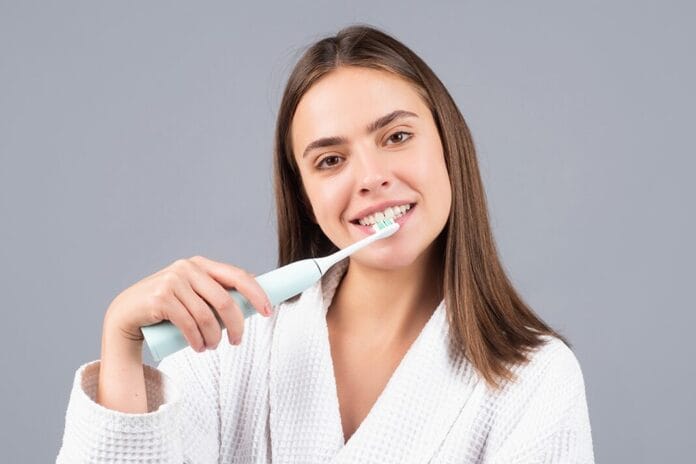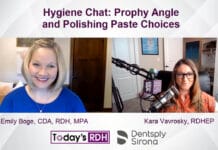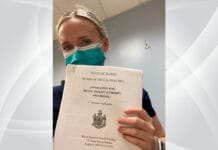Perhaps one of the oldest dental questions to date could quite possibly be one of the simplest tasks of all, and yet, it is still debated among dental professionals alike. While the importance lies within the actual implementation and technique, we still find ourselves contemplating the proper sequence of interdental cleaning and brushing.
Firstly, shall we state the obvious? Brushing and interdental cleaning are both pivotal to thoroughly cleaning the oral cavity. Each task holds equal importance, and one without the other simply will not suffice in providing optimal oral health.
Tooth brushing alone only removes at most 60% of supragingival plaque as the bristles cannot sufficiently reach interproximal areas.1 Interdental sites present the highest level of plaque accumulation both anteriorly and posteriorly, with premolars and molars being the predominant sites of residual plaque contributing to higher risks of caries and periodontal lesions.2
Several variations of interdental cleaning aids are available, such as interproximal brushes, string floss, water flossers, and floss picks, to name a few. According to the American Dental Association, string floss is the most widely used method of interdental cleaning.3
Various opinions float around the web on whether one interdental cleaning method is superior to the other. I find that meeting patients where they are and tailoring my suggestions according to their needs works best. After all, something is better than nothing.
Unfortunately, it is not known exactly how many people clean interdentally regularly. The internet is full of varying statistics on the issue. One survey conducted by Delta Dental revealed that of those polled, only 31% of adults admitted to cleaning interdentally at least once a day regularly, and 79% reported they brush twice daily.4 However, one report uncovered that many lie to their dentist about interdental cleaning (we already know this), which has me second-guessing the accuracy of the survey results.5
Research About Interdental Cleaning and Brushing Sequence
So, let’s get to the pressing question: What sequence is best if you are one of the few who brush and clean interdentally? Well, that depends on who you ask and what study you read.
A 2021 systemic review analyzed research that had been conducted up to that date and concluded that the evidence did not show a significant amount of plaque reduction in regard to the interdental cleaning and brush sequence but also went on to say that more studies were needed.6
However, a study in the Journal of Periodontology showed that the interdental cleaning and brush sequence proved to remove more interdental and whole plaque and added that fluoride remained at higher levels in the mouth when interdental cleaning before brushing. The same study did state there was no significant difference in marginal plaque.7
Another study also concluded that flossing prior to brushing resulted in significantly lower plaque scores than brushing first.8 The American Association of Orthodontists, among many other dental professionals across the web, collectively suggests that interdental cleaning prior to brushing is the correct sequence.9
Sweep Before Mopping
Not that I was asked, but I also have my own opinion on the matter. I feel that interdental cleaning prior to brushing is the proper sequence. As the queen of analogies, I like to explain it like this: When cleaning floors, one always sweeps prior to mopping to remove any loose debris. I have personally never seen anyone do the opposite for good reason.
Cleaning our teeth should be conducted in the same manner: Sweep (clean interdentally) and then follow with mopping (brushing). I often say brush off what you flossed out.
In Closing
While the evidence is varying and fails to predominately sway the opinion in one certain direction, I think that the research that has been conducted seems to favor the interdental clean followed by brush sequence. I firmly believe the dental community would agree that if our patients both simply brushed and cleaned interdentally in any sequence, we would be elated. The technique can always be mastered later.
Before you leave, check out the Today’s RDH self-study CE courses. All courses are peer-reviewed and non-sponsored to focus solely on high-quality education. Click here now.
Listen to the Today’s RDH Dental Hygiene Podcast Below:
References
- Mascarenhas, A., Okunseri, C., Dye, B. (Eds.). (2019). Plaque Control and Promotion of Periodontal Health. In V. M. Spolsky (Ed.), Burt and Eklund’s Dentistry, Dental Practice, and the Community (7th ed., pp. 305-312). Saunders. https://doi.org/10.1016/b978-0-323-55484-8.00027-7
- Ng, E., Lim, L. An Overview of Different Interdental Cleaning Aids and Their Effectiveness. Dentistry Journal. 2019; 7(2): 56. https://doi.org/10.3390/dj7020056
- Fleming, E.B., Nguyen, D., Afful, J., et al. Prevalence of Daily Flossing Among Adults by Selected Risk Factors for Periodontal Disease – United States 2011–2014. Journal of Periodontology. 2018; 89(8): 933-939. https://aap.onlinelibrary.wiley.com/doi/10.1002/JPER.17-0572
- Delta Dental Plans Association. (2023). The 2023 State of America’s Oral Health and Wellness Report. Delta Dental. https://www.deltadental.com/content/dam/ddpa/us/en/state-of-america%27s-oral-health-and-wellness-report/DDPA_State%20of%20Oral%20Health%20Report_2023-Release_FINAL.pdf
- Dentavox Survey: Majority of Patients Have Lied to Their Dentist. (2020, July 24). News Medical and Life Sciences. https://www.news-medical.net/news/20200724/Dentavox-survey-Majority-of-patients-have-lied-to-their-dentist.aspx
- Silva, C., Albuquerque, P., de Assis, P., et al. Does Flossing Before or After Brushing Influence the Reduction in the Plaque Index? A Systematic Review and Meta‐analysis. International Journal of Dental Hygiene. 2022; 20(1): 18-25. https://onlinelibrary.wiley.com/doi/epdf/10.1111/idh.12546
- Mazhari, F., Boskabady, M., Moeintaghavi, A., Habibi, A. The Effect of Toothbrushing and Flossing Sequence on Interdental Plaque Reduction and Fluoride Retention: A Randomized Controlled Clinical Trial. Journal of Periodontology. 2018; 89(7): 824-832. https://aap.onlinelibrary.wiley.com/doi/10.1002/JPER.17-0149
- Torkzaban, P., Arabi, S.R., Sabounchi, S.S., Roshanaei, G. The Efficacy of Brushing and Flossing Sequence on Control of Plaque and Gingival Inflammation. Oral Health & Preventive Dentistry. 2015; 13(3): 267-273. https://pubmed.ncbi.nlm.nih.gov/25197738/
- Should You Brush or Floss First? A Guide to Optimal Oral Hygiene. (2020, February 17). American Association of Orthodontists. https://aaoinfo.org/blog/should-i-floss-or-brush-first/











